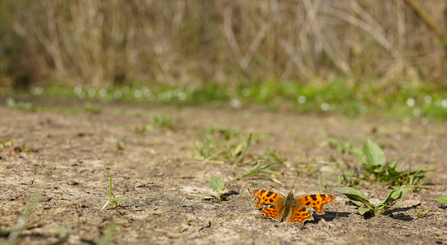
Comma butterfly by Steve Aylward
Butterflies will be attracted into any garden that offers shelter from the wind and a supply of nectar from flowering plants. There are more than 30 different species of butterfly in Suffolk, though many are becoming rarer due to losses of wildflower meadows, hedgerows and woodlands.
Butterflies need a supply of sugar-rich nectar from flowers, which come from a variety of native flowering shrubs and wildflowers. By planting a good selection of garden flowers or herbs, it is possible to provide an ample supply of nectar from March to September, when butterflies are on the wing.
What plants are best for butterflies?
It’s not just flowers that can sustain butterflies, over-ripe or rotting fruit can provide an autumn feast for late garden visitors. Here are some of the bushes, garden flowers, herbs and wildflowers that can help make your garden a one-stop shop for Suffolk’s species.
| Spring | Summer | Autumn | |
| Bushes and climbers |
Pussy Willow |
Buddleia |
Buddleia Over-ripe fruit Ivy blossom |
| Garden flowers | Aubretia Primrose Honesty Sweet rocket |
Globe-thistle Cornflower Red valerian Candytuft Lobelia |
Sedum spectabile Michaelmas daisy Sweet scabious Verbena bonariensis Heathers |
| Herbs | Lavender Marjoram Mint/catmint Thyme |
Hyssop | |
| Wildflowers | Dandelion Bugle Bird's foot Trefoils |
Knapweed Red clover Field scabious |
Viper's bugloss Devil's-bit scabious Hemp agrimony |
Two particular plants deserve special mention when it comes to attracting butterflies into gardens and encouraging them to stay and breed.
Nettles
Perhaps the easiest type of butterfly to tempt over the garden fence are the nettle feeders. Stinging nettles planted in an old tub buried in the ground (to prevent them spreading and becoming a nuisance) in a sunny sheltered position will soon attract species such as red admiral, peacock, small tortoiseshell and comma. Small tortoiseshells prefer young nettle growth, so it is a good idea to cut down part of your nettles in late June or July (removing any caterpillars first) to allow the next generation of butterflies to benefit from the re-growth.
Grasses
Even more popular than nettle, is grass, the host plant for no less than ten of our butterflies. The entire family of "Browns" and three of the Skippers require grassland to breed. Simply by leaving wide strips of un-mown grass around the margins of your land, you can have meadow browns, gatekeepers, large and small skippers breeding at home.
Caterpillars need the protection of tussocks, they come up the stem to feed, mainly at night, and get right down in the clump to over winter. Let wildflowers grow in the margin too, as the extra nectar will help; if you have space, you could even establish a wildflower meadow.
Suffolk's butterflies
| English name | Status | Foodplant |
| Small Skipper | Common | Grasses |
| Essex Skipper | Common | Grasses |
| Large Skipper | Common | Grasses |
| Dingy Skipper | Suffolk BAP | Bird's-foot trefoil |
| Clouded yellow | Migrant | Clover & Lucerne |
| Brimstone | Common | Buckthorn |
| Large White | Common | Brassicas |
| Small White | Common | Brassicas |
| Green-veined White | Common | Cruciferae |
| Orange Tip | Common | Garlic mustard |
| Green Hairstreak | Local | Gorse, Broom |
| Purple Hairstreak | Local | Oak |
| White-letter Hairstreak | Rare | Elm |
| Small Copper | Common | Sorrel |
| Brown Argus | Common | Rock-rose |
| Common Blue | Common | Trefoils |
| Holly Blue | Common | Holly, Ivy |
| Silver-studded Blue | BAP | Heather, gorse |
| White Admiral | Woodland | Honeysuckle |
| Red Admiral | Common | Nettle |
| Painted Lady | Migrant | Thistle |
| Small Tortoiseshell | Common | Nettle |
| Peacock | Common | Nettle |
| Comma | Common | Hops, Nettle |
| Speckled Wood | Common | Grasses |
| Wall | Local | Grasses |
| Grayling | Heathland | Grasses |
| Gatekeeper | Common | Grasses |
| Meadow Brown | Common | Grasses |
| Ringlet | Common | Grasses |
| Small Heath | Common | Grasses |

